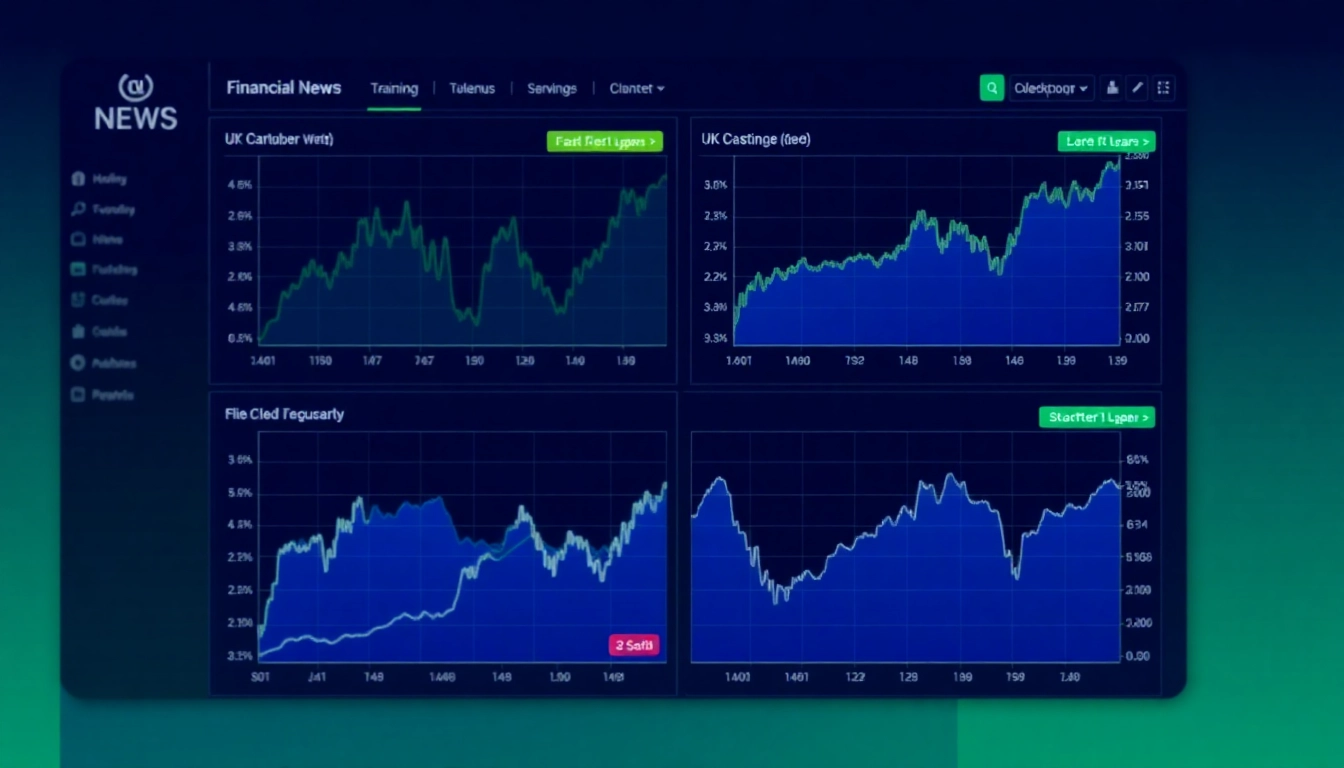
Understanding Current UK House Price Trends
Recent data indicates that UK house prices are demonstrating resilience amidst a landscape of economic uncertainties and shifting lending practices. As of September 2023, the average house price has increased by approximately 7.7% annually, with the typical home now costing around £16,000 more than a year ago. This growth reflects a combination of factors including limited housing supply, robust demand, and heightened activity in certain regions. Notably, the “effective” interest rate—the actual mortgage interest paid on new loans—has declined for five consecutive months, reaching 4.28%, making borrowing slightly more affordable for aspiring homeowners and investors alike. Such trends are pivotal for anyone aiming to understand the broader housing market dynamics and to anticipate future movements.
For those seeking an in-depth perspective, UK House Prices serve as a critical benchmark for assessing market health and affordability. Analyzing recent figures and projections helps inform strategic decision-making, whether for purchasing a family home or structuring a property investment portfolio.
Factors Influencing the 3% Price Rise in 2025
The anticipated 3% increase in UK house prices in 2025 stems from a multifaceted set of influences. Firstly, the ongoing housing shortage—deemed “dire” by the Royal Institution of Chartered Surveyors (RICS)—continues to exert upward pressure on prices. In August 2023, residential transaction volumes reached nearly 96,000, a modest increase, but not enough to counteract supply constraints.
Economic factors such as inflation, wage growth, and low interest rates contribute significantly. While mortgage rates remain relatively high, the decline in the effective interest rate indicates some easing in borrowing costs. Additionally, illicit funds entering the market and being laundered into property transactions have artificially boosted prices by an estimated £3,000 nationwide, especially impacting London. collectively, these elements create a market environment primed for modest but steady growth.
Expert analyses also suggest that policy changes, like potential adjustments to property taxes or stamp duty, and wider macroeconomic trends like inflation and currency fluctuations, will influence the rate of increase. While some factors may temper growth, structural supply shortages are likely to maintain upward pressure, making the 3% rise a reasonable forecast for 2025.
Impact of Economic Conditions on Housing Prices
The evolving economic landscape plays a crucial role in shaping UK house prices. For instance, rising mortgage costs due to higher base rates tend to dampen affordability, discouraging some buyers. However, recent reductions in the “effective” mortgage interest rate have mitigated this effect temporarily, supporting continued demand.
In addition, economic uncertainties such as Brexit-related trade adjustments, inflation targets, and potential new taxes—like property or stamp duty reform—can introduce volatility. RICS reports a housing shortage exacerbated by stagnant supply, which keeps prices high despite fluctuating economic signals. Meanwhile, the increase in house prices via illicit money inflows illustrates how financial crime can distort genuine market demand, leading to inflated valuations that may not reflect underlying economic fundamentals.
As economic conditions stabilize or improve, we could expect a modest correction or a pause in price growth; however, persistent supply constraints suggest that prices are poised to steadily increase over the medium term, including through 2025.
Implications for Homebuyers and Investors
How Price Increases Affect Affordability
Rising house prices directly impact affordability, especially for first-time buyers and those on modest incomes. An annual increase of 7.7% suggests that saving for a deposit must accelerate or income levels must improve correspondingly. For example, if the average house now costs around £290,000, a 3% increase in 2025 would push prices closer to £300,000, challenging many prospective buyers.
This scenario emphasizes the importance of tailored mortgage products, such as fixed-rate deals or flexible lending options, to lock in current rates and manage future costs effectively. Additionally, government initiatives like Help to Buy or shared ownership schemes can play vital roles in maintaining access to the market.
Best Strategies for Property Investment in a Growing Market
Investors should focus on regions with supply shortages and high rental demand. According to recent market insights, university cities and growing urban centers—such as Manchester, Birmingham, and Bristol—offer promising prospects. Diversification across property types, including residential for buy-to-let, student accommodation, or holiday rentals, can mitigate risks and enhance income streams.
Furthermore, leveraging lower-interest fixed mortgage rates, capitalizing on government incentives, and conducting thorough due diligence on regional price trends are crucial. Long-term outlooks should consider the impact of potential policy shifts, macroeconomic factors, and market cycles.
Loan Options and Mortgage Rates for UK House Prices
Mortgage options remain a critical consideration. Recent figures show a decline in mortgage product choices, with total options falling to around 6,842, according to the latest Moneyfacts UK Mortgage Trends Treasury Report. Short-term deals and two-year fixed-rate mortgages currently dominate, with 46% of borrowers opting for shorter fixes.
Additionally, major lenders have withdrawn sub-4% home loans amid tightening lending criteria. For homebuyers and investors, navigating this landscape requires careful planning. Fixed-rate mortgages, despite higher initial payments, can offer stability in unpredictable economic climates, while variable-rate or interest-only products might appeal to those expecting rates to fall or seeking flexible repayment terms.
Exploring specialist lending options is vital, especially for rejected applicants or those with unique financial circumstances. Partnering with experienced mortgage brokers can unlock tailored solutions aligned with market conditions.
Navigating the UK Property Market
Current Challenges and Opportunities
One of the foremost challenges is the persistent house shortage, which sustains high prices and reduces transaction volumes. Simultaneously, rising mortgage rates and stricter lending criteria make access to finance more complex.
Despite these hurdles, opportunities exist in niche markets like student housing and rental property investments, which are increasingly attractive for generating passive income. The surge in remortgage completions and the dip in mortgage rates suggest some resilience in the market, providing avenues for strategic refinements.
Legal and Regulatory Changes to Watch
Recent legislative developments, such as discussions around property tax reforms and anti-money laundering regulations, can influence market dynamics. An example includes the potential introduction of new taxes or adjustments to stamp duty, aimed at cooling overheated markets or curbing illicit funds inflows.
Being aware of these changes enables proactive planning, ensuring compliance while optimizing investment returns. Consulting with legal experts and staying informed through professional channels is vital for navigating evolving regulatory landscapes.
Timing Your Purchase During Market Fluctuations
Strategic timing is essential to maximize value. Monitoring interest rate trends, government policy announcements, and regional price movements can help investors and buyers identify optimal entry points. For instance, market dips following policy announcements or economic downturns may offer discounted entry opportunities.
Utilizing market indicators such as transaction volumes, price volatility, and mortgage approval rates facilitates informed decision-making. Partnering with local estate agents and financial advisors enhances timing precision and mitigates risk.
Forecasting Future Trends in UK House Prices
Predicted Trends Beyond 2025
Beyond 2025, experts anticipate continued moderate growth driven by supply constraints and demographic shifts. The backlog of housing shortages, coupled with increasing demand due to population growth and urbanization, suggests that prices will likely plateau around 2-3% annual increments.
Technological innovations and policies aimed at boosting supply, such as modular housing or reforming planning permissions, could influence these projections. Conversely, economic shocks or global uncertainties may introduce volatility, emphasizing the importance of adaptable investment strategies.
Impact of Policy and Taxation Changes
Government policies, including potential reforms to stamp duty and increased property taxes, could temper house price growth. For example, higher stamp duties or land taxes might reduce transaction volumes, impacting price momentum.
Investors must stay alert to such developments, assessing their influence on yield and capital appreciation. These changes could also shift demand toward regions with attractive tax advantages or less regulation.
Regional Variations in Price Growth
Regional disparities remain prominent, with markets like London and the Southeast traditionally exhibiting higher growth rates, often exceeding national averages. Conversely, northern cities and peripheral regions may experience slower or more volatile price movements.
Tailoring investment approaches regionally is prudent, considering factors such as local employment rates, infrastructure development, and demographic trends. Data-driven insights enable investors to focus on emerging hotspots or resilient markets.
Practical Tips for Buyers and Investors
Maximizing Your Investment Returns
To optimize returns, conduct thorough due diligence on regional price trends, rental yields, and future growth prospects. Leveraging affordable mortgage rates via fixed-rate deals secures cost stability, while diversification across property types spreads risk.
Moreover, considering short-term rental opportunities or student accommodation can boost cash flow. Employing professional property management and maintaining updated knowledge of market policies enhances overall profitability.
Understanding Market Indicators and Data
Key indicators include transaction volumes, average property prices, mortgage approval rates, and rental yields. Monitoring these metrics provides insight into market momentum and potential turning points. For instance, a decline in mortgage approvals may signal reduced buyer confidence.
Utilize reputable sources such as HMRC transaction data, property portals, and industry reports to stay informed. Combining quantitative data with qualitative market sentiment offers a comprehensive view for strategic decisions.
Preparing Finances for Future Property Purchasing
Financial readiness entails checking credit scores, saving for deposits, and exploring suitable mortgage products now. Maintaining good credit and understanding eligibility criteria can streamline application processes.
Estimating future costs, including stamp duty, legal fees, and renovation expenses, ensures realistic budgeting. Seeking advice from mortgage brokers and financial advisors maximizes affordability and secures optimal terms.




